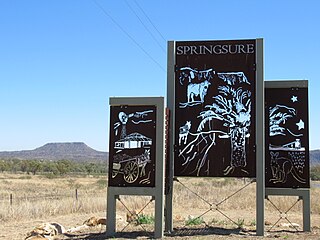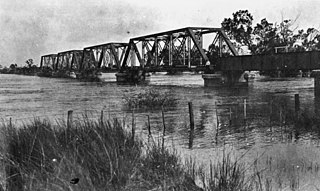
The Gayiri, people, also spelt or known as Kairi, Kararya, Kari, Khararya and Kaira, Bimurraburra, Gahrarja, Gara Gara, Ara Ara, and Kara Kara, [1] are an Aboriginal Australian people of the state of Queensland.

The Gayiri, people, also spelt or known as Kairi, Kararya, Kari, Khararya and Kaira, Bimurraburra, Gahrarja, Gara Gara, Ara Ara, and Kara Kara, [1] are an Aboriginal Australian people of the state of Queensland.
According to an estimation made by Norman Tindale, the Kairi held sway over some 5,900 square miles (15,000 km2) of territory, from the Great Dividing Range south of Springsure [lower-alpha 1] north to Capella. The Drummond Range formed their western frontier, while their eastern boundaries were drawn by the Comet and upper Mackenzie (Nogoa) rivers. [3]
The Kairi were divided into hordes, the name of at least one of which is known.
Gayiri men were involved in the Cullin-la-ringo massacre, in which 19 settlers were killed as retribution after Gayiri men had been murdered after being falsely accused of stealing cattle. Settlers and native police killed around 370 Gayiri people in reprisal killings. [4]

Springsure is a rural town and locality in the Central Highlands Region, Queensland, Australia. In the 2021 census, the locality of Springsure had a population of 950 people.

The Kaytetye, also written Kaititya, and pronounced kay-ditch, are an Aboriginal Australian people who live around Barrow Creek and Tennant Creek in the Northern Territory. Their neighbours to the east are the Alyawarre, to the south the Anmatyerre, to the west the Warlpiri, and to the north the Warumungu. Kaytetye country is dissected by the Stuart Highway.

The Cullin-la-ringo massacre, also known as the Wills tragedy, was a massacre of white colonists by Indigenous Australians that occurred on 17 October 1861, north of modern-day Springsure in Central Queensland, Australia. Nineteen men, women and children were killed in the attack, including Horatio Wills, the owner of Cullin-la-ringo station. It is the single largest massacre of colonists by Aboriginal people in Australian history. In the weeks afterwards, police, native police and civilian posses carried out "one of the most lethal punitive expeditions in frontier history", hunting down and killing up to 370 members of the Gayiri Aboriginal tribe implicated in the massacre.
The Jardwadjali (Yartwatjali), also known as the Jaadwa, are an Aboriginal Australian people of the state of Victoria, whose traditional lands occupy the lands in the upper Wimmera River watershed east to Gariwerd (Grampians) and west to Lake Bringalbert.

The Nogoa River is a river in Central Queensland, Australia.
The Bungandidj people are an Aboriginal Australian people from the Mount Gambier region in south-eastern South Australia, and also in western Victoria. Their language is the Bungandidj language. Bungandidj was historically frequently rendered as Boandik, Buandig, or Booandik.
The Yapurarra or Jaburara, also rendered Yaburara, are an Aboriginal Australian people whose traditional lands are in the Pilbara region of Western Australia and the Dampier Archipelago.
The Tanganekald people were or are an Aboriginal Australian people of South Australia, today classed as part of the Ngarrindjeri nation.
The Tulua people were an Aboriginal Australian people of Queensland, in the southern to central region from the coast to the ranges. The Dappil and Tulua people possibly spoke the same language.
The Wirngir are an Aboriginal Australian people of the Kimberley region of Western Australia.
The Djaru people are an Aboriginal Australian people of the southern Kimberley region of Western Australia.
The Bidjara or Pitjara are an Aboriginal Australian people of eastern Queensland. They are to be distinguished from the Bidjara of southwestern Queensland and the Badjiri of southern Queensland.
The Kalibamu, also known as the Kotanda, were an Aboriginal Australian people of the state of Queensland.
The Miyan, or Mian, were an indigenous people of the state of Queensland.
The Ganulu, also spelt Kanolu, are an Aboriginal Australian people of the state of Queensland.
The Karuwali are an Aboriginal Australian people of the state of Queensland.
The Koa (Guwa) are Australian Aboriginal people and Native Title Holders of land in the Upper Diamantina River catchment area in the state of Queensland that includes the towns of Winton, Kynuna, Corfield and Middleton.
The Yagalingu are an Aboriginal Australian people of the state of Queensland. Their language may have been a dialect of Bidjara.

The Nauo people, also spelt Nawu and Nhawu, are an Aboriginal Australian people of the south-western Eyre Peninsula in South Australia. The Nauo language became extinct by the twentieth century, but efforts are being made to revive it.
The Garaynbal, also written Karingbal, are an Aboriginal Australian people of the state of Queensland. They spoke a dialect of Biri called Garaynbal, now extinct.